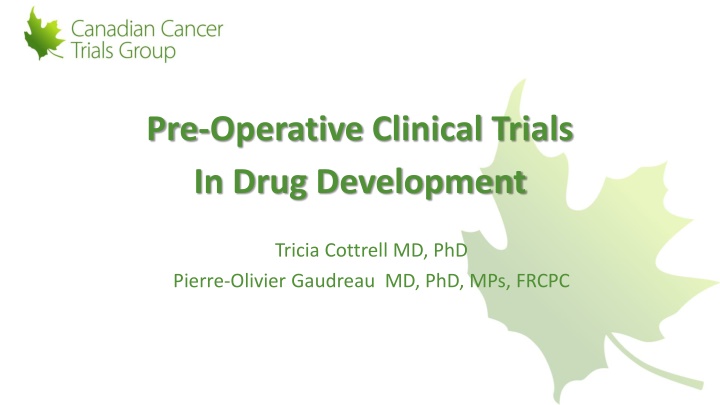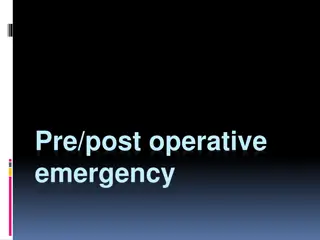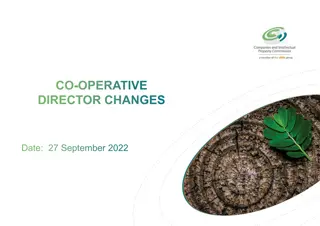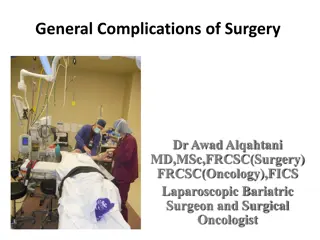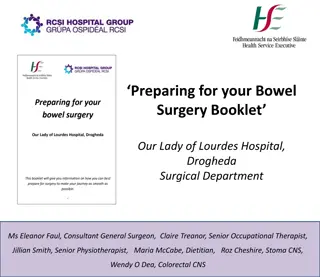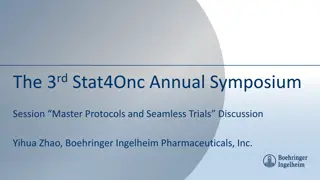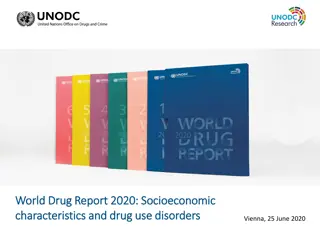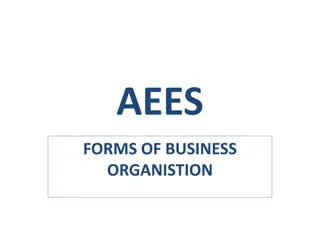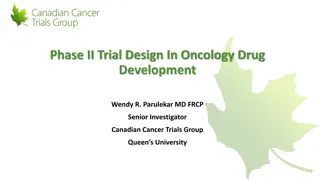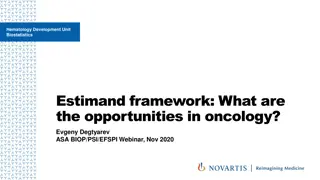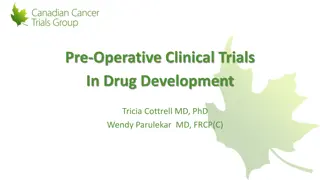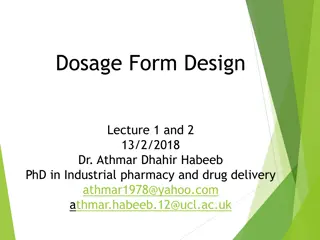Pre-Operative Trials in Oncology Drug Development
Clinical trials in the peri-operative setting play a crucial role in evaluating novel therapies for cancer treatment. This includes pre-operative neoadjuvant and post-operative adjuvant trials, as well as peri-operative trials that integrate both components. The paradigm of drug development in oncology has evolved over the years, focusing on toxicity, targeted therapy, and immunotherapy. Leveraging the pre-operative setting can accelerate drug and biomarker development, offering a unique opportunity to improve outcomes for cancer patients.
Download Presentation

Please find below an Image/Link to download the presentation.
The content on the website is provided AS IS for your information and personal use only. It may not be sold, licensed, or shared on other websites without obtaining consent from the author.If you encounter any issues during the download, it is possible that the publisher has removed the file from their server.
You are allowed to download the files provided on this website for personal or commercial use, subject to the condition that they are used lawfully. All files are the property of their respective owners.
The content on the website is provided AS IS for your information and personal use only. It may not be sold, licensed, or shared on other websites without obtaining consent from the author.
E N D
Presentation Transcript
Pre-Operative Clinical Trials In Drug Development Tricia Cottrell MD, PhD Pierre-Olivier Gaudreau MD, PhD, MPs, FRCPC
Workshop Objectives To identify role(s) of pre-operative trials in cancer drug development Identify key trial elements that guide the design of pre-operative trials Design a pre-operative platform trial testing novel agents in patients with resectable NSCLC 2
Clinical Trials in the Peri-Operative Setting Pre-operative Neoadjuvant: Therapeutic intent trials that test novel treatment; use an intermediate endpoint measured at surgery e.g. pathologic complete response measured to surgery Window of Opportunity (now usually referred to as Pre-operative Biomarker Studies): Non therapeutic trials that test novel therapies; use a feasibility or biomarker endpoint measured at surgery Ki-67 status Post-operative clinical trials Adjuvant: Therapeutic intent trials that test novel treatment strategies; use surgical findings to assign treatments (e.g. presence of residual disease); clinically validated endpoints e.g. disease-free survival Peri-operative clinical trials Therapeutic intent trials that incorporate both neoadjuvant and adjuvant treatment components 3
Drug Development In Oncology Paradigm of drug development in the era of cytoxic chemotherapy Direct relationship between toxicity and anti-tumour effect Normal tissue dose limiting toxicity used to select active dose for further testing Paradigm of drug development in the era of targeted therapy May not have direct relationship between toxicity and target inhibition Plateau in target inhibition may occur at lower level than the MTD Greater emphasis on understanding the drug target Paradigm of drug development in the era of immunotherapy May not have direct relationship between toxicity and anti-tumour effect MTD usually not reached Identifying biomarkers remains a challenge 4
Drug Development In Oncology Oncology drug development Expensive Time consuming Inefficient high failure rate from drug discovery to regulatory approval The pre-operative setting provides a unique opportunity to accelerate drug and biomarker development by enabling a comprehensive assessment of the pharmacodynamic effects of a novel therapy Patients are also less likely to have developed acquired drug resistance 5
Pre-Operative Clinical Trials in Drug Development Advantages Optimizes the intersection of research and practice workflows In vivo assessment of drug activity Collection of biospecimens for biomarker discovery/validation Surrogate endpoint identification/validation Operative findings to guide adjuvant therapy decisions Treatment naive patients are more likely to have better tolerability and compliance to treatment May offer access to innovative treatments in countries where new neoadjuvant SOC will only slowly or never be made available 6
Pre-Operative Clinical Trials in Drug Development Challenges Enhanced multidisciplinary collaboration Surgery, Medical Oncology, Pathology, Radiology, Radiation Oncology Experienced multidisciplinary case conference is mandatory Complex consenting procedure Non therapeutic intent pre-operative trials Safety considerations and ensuring equipoise Delays in surgery or surgical complications All available knowledge about activity and safety must be evaluated Data from randomized Phase 2 trials in the advanced disease setting should be available Rapidly changing treatment landscape and new SOCs Next steps How do the results impact continued drug development? 7
General Classification of Pre-Operative Clinical Trials Therapeutic Non-Therapeutic Neoadjuvant Administration of multiple cycles of therapy Novel therapy + standard of care Intermediate endpoint e.g. pCR Window of Opportunity (Preoperative Biomarker Studies) Limited administration of a novel therapy (usually 2-3 weeks) Single agent or combination with standard of care Feasibility and/or molecular endpoint e.g. % compliant; change in biomarker(s) 8
Key Design Elements Objective(s) Estimate drug activity; feasibility; tolerability and safety Patient Population All comers versus molecularly defined Endpoint(s) Measure of anticancer activity; change in molecular target; compliance e.g. pCR; change in biomarker; percentage compliant Pathology endpoints: Generally consideredsurrogatesof OS for breast cancer, but less well validated in other tumourtypes Major pathologicalresponse(mPR) not always standardized Responseto cytotoxictherapy vs targetedagents vs IO Need to collectdata that allowsurvival-basedendpoints(e.g. event-free survival) for validation of surrogateendpoints Exploratory endpoints: ctDNA clearance; FDG-PET response; novel imagingtechnologies (e.g. image mass cytometry) Considerationof Patient Reported Outcomes Statistical Framework H0, HA, (Type 1 error), (Type II error); comparative measures e.g. hazard ratio (hazard ratio) 9
Additional Clinical Design Factors Standard times from the diagnosis to surgery Based on local clinical practice, potential impact of delays, prognosis, likelihood of relapse, availability and effectiveness of salvage treatments, available evidence on the long-term outcomes of definitive locoregional treatments If applicable, turnaround time to access biomarker results Surgery needs to be standardized to limit potential variability and bias Consideration of adjuvant treatment portion if follow up Phase 3 peri-operative trials are contemplated Experimental neoadjuvant therapy should not preclude the delivery of available evidence-based SOC treatment, including adjuvant therapies e.g. Access to adjuvant IO may be limited to patients who have not received it as neoadjuvant treatment Whether tumour downsizing might reduce long-term morbidity in addition to how promising the experimental treatment is For many tumour types, neoadjuvant SOC treatment is changing frequently as new trial results are reported and new regimens are approved and supported by funders / payers, leading to variation in what might be considered neoadjuvant SOC treatment Given the curative intent, the risks of fertility loss, irreversible toxicity, and second malignancies must be considered and adequately monitored 10
Methodology for the Development of Innovative Cancer Therapies Taskforce (MDICT) 2024 Recommendations for Testing New Anticancer Drugs Before Curative Locoregional Therapies Two core concepts proposed for design: 1. Supportive data from advanced disease settings 2. Contemporaneous randomized control to allow conclusions to be drawn that would stop further development in the neoadjuvant setting Consideration of platform studies and adaptive trial designs 11 MDICT Taskforce, ESMO Open, 2024
EXAMPLE 1 12
NEOSTAR Trial 13 Cascone et al., Nature Medicine, 2021, 2023
General Classification of Pre-Operative Clinical Trials Therapeutic Non-Therapeutic Neoadjuvant Administration of multiple cycles of therapy Novel therapy + standard of care Intermediate endpoint e.g. pCR Window of Opportunity Limited administration of a novel therapy Single agent or combination with standard of care Feasibility and/or molecular endpoint e.g. % compliant; change in biomarker 14
EXAMPLE 2 15
A Phase II Study of Neoadjuvant PD-L1 versus PD-L1 plus CTLA-4 Blockade for Patients with Malignant Pleural Mesothelioma Primary objective: Primary objective: Alteration of the intratumoral CD8/regulatory T cell (Treg) ratio after combination immune checkpoint blockade (ICB) therapy Secondary and Secondary and exploratory objectives: exploratory objectives: Other changes in the tumor micro-environment, survival, safety, tumor pathologic response (PR), and systemic immune responses Patients without pathologic nodal or peritoneal disease were randomly assigned in a 2:2:1 ratio to receive (i) one dose of durvalumab (10 mg/kg i.v.), (ii) one dose of durvalumab (1,500 mg) plus one dose of tremelimumab (75 mg i.v.), or (iii) no ICB. 16 Lee et al., Clin Cancer Res, 2023
General Classification of Pre-Operative Clinical Trials Therapeutic Non-Therapeutic Neoadjuvant Administration of multiple cycles of therapy Novel therapy + standard of care Intermediate endpoint e.g. pCR Window of Opportunity Limited administration of a novel therapy Single agent or combination with standard of care Feasibility and/or molecular endpoint e.g. % compliant; change in biomarker 17
